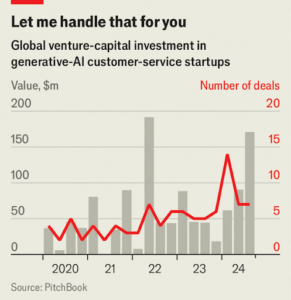Whether you love or fear AI, not paying attention to GenAI, especially in the customer experience (CX) space, is like burying your head in the sand, while the AI sandstorm is fast approaching.
According to The Economist article “Can Artificial Intelligence Rescue Customer Service”, published on Oct. 16, 2024, the “latest” (in this fast-moving) GenAI in the CX space is shown in this graph:
Chart: The Economist
The data gathered by PitchBook in this graph shows investment in startups developing GenAI CX tools reached $171 MM globally in the third quarter of 2024, up from $45 MM in the same period 2023.
Meanwhile, hundreds of millions are being raised for GenAI CX startups. Tech giants such as Microsoft, Alphabet, Amazon, and Salesforce are also bringing GenAI to their customer-services. Others are using OpenAI LLM to develop their own CX bots.
“Unlike their rote-learning predecessors, generative-AI bots do not regurgitate canned answers to narrow questions. Instead, they create their own responses informed by the firms’ training materials and previous customer-service interactions.” https://www.economist.com/business/2024/10/16/can-artificial-intelligence-rescue-customer-service
GenAI promises personalized CX that is timely and tailored, which can make customers feel understood, served, and prioritized. This can lead to customer-centered CX rather than the old company-centric, one-size-fits-all customer “service” that prioritizes the organization’s operational efficiency, at the cost of customer frustration.
However, the accuracy and quality of GenAI CX solutions entirely depend on the data “ingredients” the AI model is trained on. When there is insufficient or unclean data, AI hallucinates and provides wrong answers with complete confidence. One example, among many, is Air Canada’s AI chatbot that falsely offered a discount to a customer.
To responsibly leverage GenAI in CX by minimizing disinformation, humans need to remain in the loop constantly, to both quality-control data and correct AI hallucinations.
As a disruptive technology, GenAI will replace traditional CX agents to some extent: “Last year Gartner predicted that generative AI would lead to a 20-30% reduction in customer-service jobs by 2026”, as quoted in the Economist.
The silver lining from GenAI disruption to the CX workforce is that agents no longer have to be the punching bags of frustrated and irate customers, often as a result of a deliberate company strategy known as “deflection” [1]. The replaced agents can pursue higher level, more enjoyable work. However, it remains to be seen if customers are better or worse served with less human workforce and more GenAI, in spite of what GenAI currently promises: more personalized CX.
What leaders in the CX space can do is to first shift from a reactive approach to GenAI to a proactive mindset. It is all too human to feel fear and anxiety when facing the unknown. Fear often leads to a fight-or-flight reaction, which does not lead to productive and innovative actions. Acknowledging fear is the first step to turn re-action to pro-action.
GenAI, like all technologies, is a tool or a partner to improve human experience and elevate humanity. It is an endless journey to take CX to a higher level of empathy, data-based prediction and anticipation, and customer delight. Humans are the drivers, end users, and the whole purpose of GenAI enabled CX.
=====================================
As a leader in the customer experience support services, ApexCX helps customer-facing companies excel with both technology and human-centered, customer-led CX assessment, design, implementation, and contact center management, from end to end. Please contact us for further information. Thank you.
©Jerry Briggs all rights reserved.
[1] “In recent years, however, the industry has become notorious for driving customers mad with its use of technology. Its poor reputation is deserved, reckons Andy Lee, co-founder of Alorica, an American contact-centered business with 100,000 employees. It is expensive for firms to use humans to solve their customers’ problems, so they make the process as cumbersome as possible by forcing them to press a bewildering combination of numbers or chat with a bot that regurgitates generic responses—a strategy known as “deflection”. Once human agents are involved, it is in the financial interests of outsourcing firms to make the process as labor intensive as possible, raising costs and frustrating everybody.” https://www.economist.com/business/2024/10/16/can-artificial-intelligence-rescue-customer-service